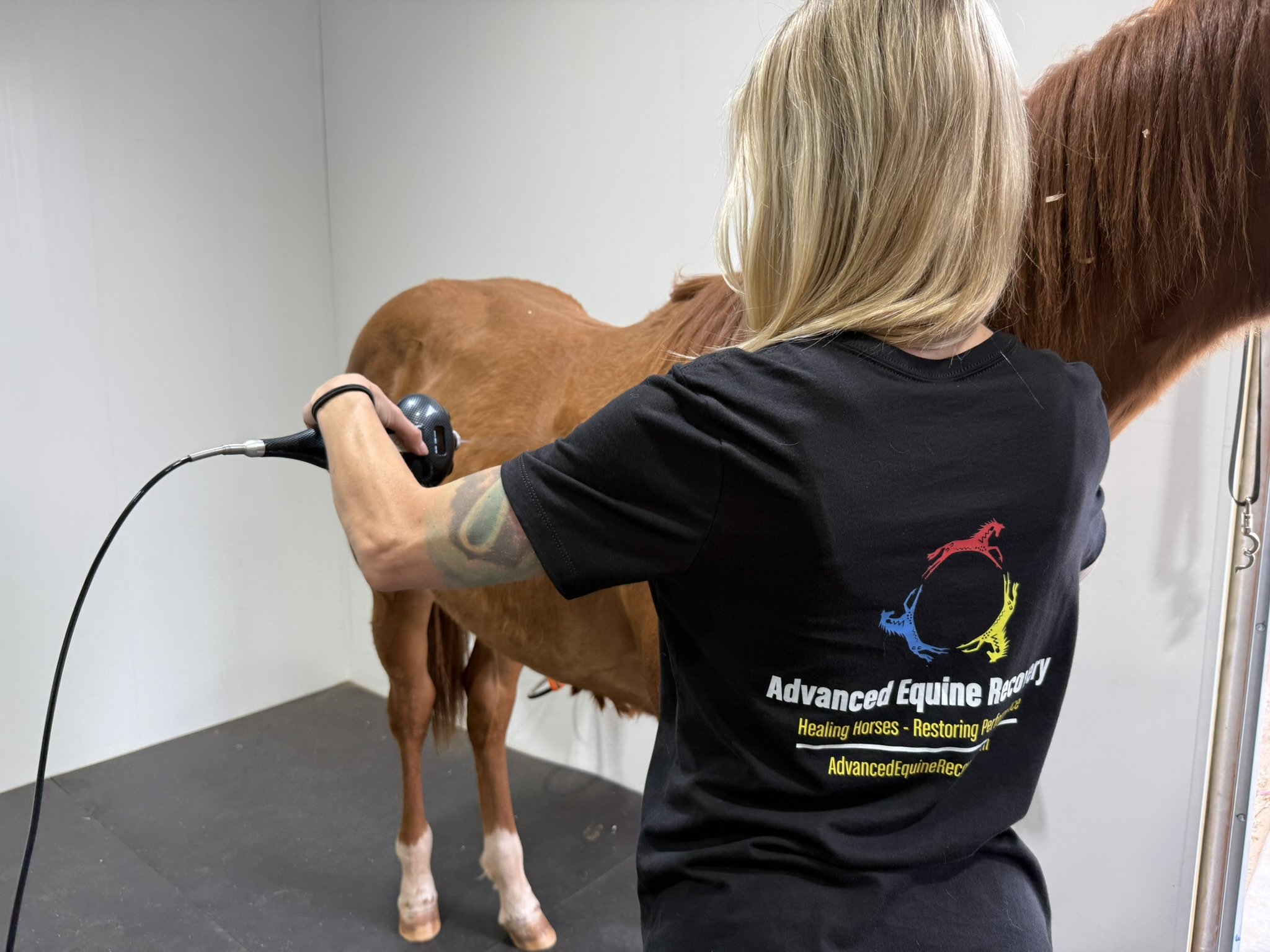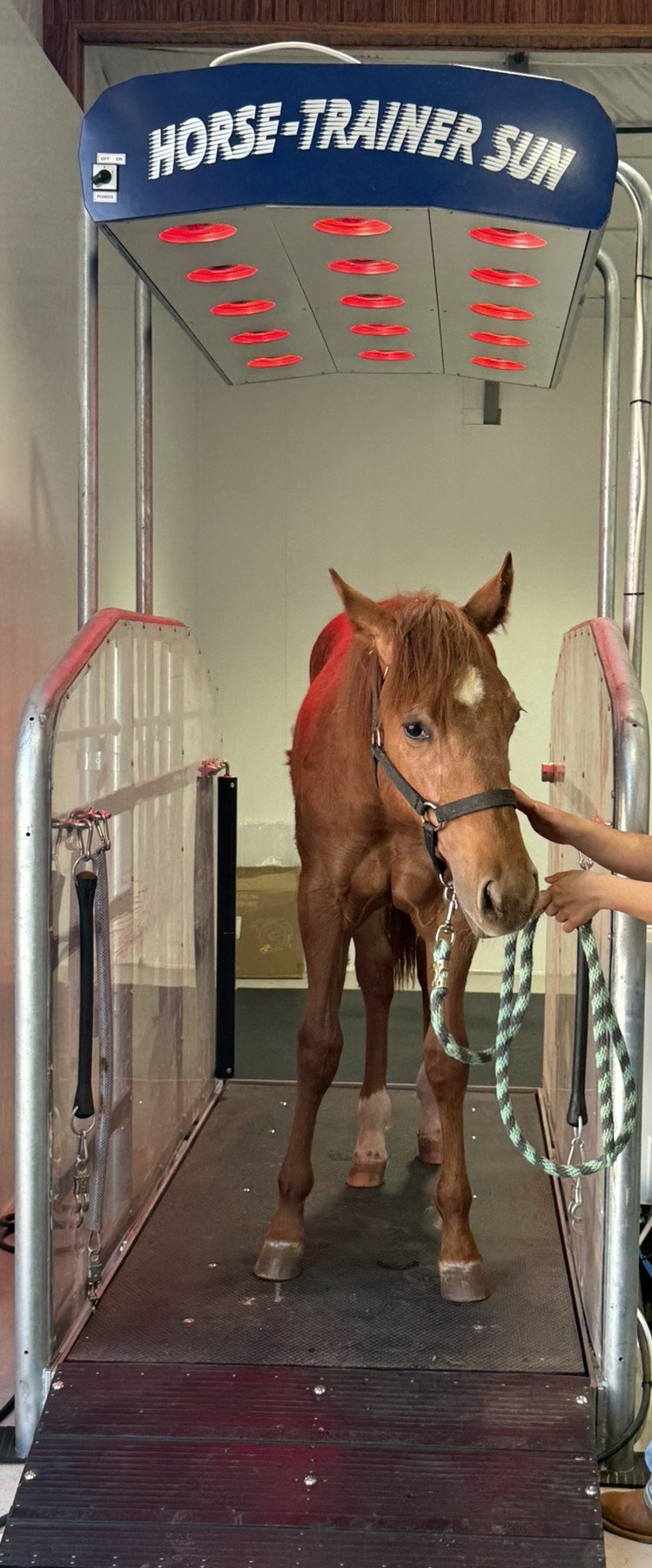Equine Water Treadmill
-
Water treadmill therapy combines buoyancy, resistance, and controlled movement to create an optimal rehabilitation and conditioning environment. Studies have confirmed its effectiveness in improving equine performance.
-
Reduced Joint and Tendon Stress: Research published in the Journal of Equine Veterinary Science found that water treadmill therapy decreases joint impact forces by 40-60%, making it ideal for horses recovering from tendon or ligament injuries.
Increased Muscle Engagement: A study conducted at the University of Zurich showed that horses using a water treadmill experienced 25-35% more hindquarter and core muscle activation compared to land-based exercise.
Enhanced Cardiovascular Fitness: Findings from Veterinary Medicine International indicate that equine water treadmill therapy improves aerobic capacity by 20-30%, supporting endurance and stamina in performance horses.
Equine Shockwave Therapy
-
Equine shockwave therapy uses acoustic pressure waves to stimulate healing and regeneration at the cellular level. Multiple studies have confirmed its effectiveness in equine rehabilitation.
-
Reduction in Pain and Inflammation: A study in Veterinary Medicine International reported that horses treated with shockwave therapy experienced a 40-60% reduction in pain levels and inflammation within a few sessions.
Enhanced Tendon and Ligament Regeneration: Findings from the University of California Davis revealed that shockwave therapy boosts cellular activity and collagen production by 30-40%, accelerating the recovery of soft tissue injuries.
Equine Class IV Laser Therapy
-
Class IV Equine Laser Therapy, particularly Tri-Wave Laser systems, utilizes specific wavelengths of light—commonly 810nm, 980nm, and sometimes 1064nm—to penetrate deep into tissues, stimulate cellular repair, and promote circulation.These systems are characterized by their high power output, often ranging from 15 to 90 watts, which enhances their therapeutic effectiveness.
-
Laser therapy has been shown to enhance collagen production, a crucial component of tissue repair, thereby speeding up the healing process and reducing scar formation. This leads to more efficient recovery from injuries and surgical procedures.
Pain Reduction & Inflammation Control:
Studies have reported that horses treated with laser therapy experience significant reductions in inflammation and pain within the first few sessions, enhancing comfort and mobility. This makes it an effective option for managing both acute and chronic musculoskeletal conditions.
Improved Muscle Recovery & Performance:
Laser therapy enhances muscle function and reduces recovery time, making it particularly beneficial for performance horses by supporting quicker return to training and competition. This contributes to improved overall performance and reduces the risk of re-injury.
Implementing Tri-Wave Class IV Laser Therapy can significantly enhance recovery and overall performance in equine patients, providing a safe and effective treatment option for various musculoskeletal and inflammatory conditions.
Equine Cryo Therapy
-
Targeted Cryotherapy is a subzero temperature-based therapy designed to reduce inflammation, relieve pain, and accelerate healing in a particular area of the horse.
-
Inflammation and Swelling Reduction: Research published in the Journal of Equine Veterinary Science found that cryotherapy can decrease inflammation markers by 40-60%, making it a powerful treatment for tendon and ligament injuries.
Pain Relief and Recovery Acceleration: A study in Veterinary Medicine International reported that horses treated with cryotherapy experienced a 30-50% reduction in pain levels and recovered from soft tissue injuries up to 35% faster than those treated with traditional methods.
Improved Circulation and Healing: Findings from the University of Kentucky showed that cryotherapy stimulates blood flow upon rewarming, enhancing oxygenation and nutrient delivery by 20-30%, which promotes faster tissue repair.
Equine Massage Therapy
-
This hands-on treatment improves circulation, reduces tension, and accelerates recovery. Equine massage stimulates soft tissues and enhances muscle function through targeted pressure and manipulation.
-
Improved Circulation and Oxygenation: Research published in the Journal of Equine Veterinary Science found that massage therapy increases blood circulation by 20-30%, which promotes faster muscle recovery and tissue repair.
Reduction in Muscle Tension and Pain: A study in Veterinary Medicine International reported that horses receiving regular massage therapy experienced a 40-50% reduction in muscle tightness and pain, leading to improved mobility.
Enhanced Flexibility and Range of Motion: Findings from the University of Kentucky showed that equine massage therapy increases joint flexibility by 25-35%, reducing stiffness and preventing injuries.
Equine PEMF-MagnaWave Therapy
-
PEMF therapy uses pulsating electromagnetic fields to stimulate cellular activity and improve circulation.
-
Increased Blood Flow and Oxygenation: Research published in the Journal of Equine Veterinary Science found that PEMF therapy increases microcirculation by 20-30%, promoting faster healing and tissue regeneration.
Reduction in Inflammation and Pain: A study in Veterinary Medicine International reported that PEMF therapy reduces inflammation markers by 25-50%, making it an effective treatment for soft tissue injuries and joint disorders.
Enhanced Cellular Regeneration: According to findings from the University of Pennsylvania School of Veterinary Medicine, PEMF therapy accelerates cell repair by 30-40%, improving recovery times for injuries and post-surgical healing.
Equine Infrared & Balancing Therapy “The Relax Solarium”
-
The Relax Solarium uses infrared light therapy combined with vibration plate technology to support equine health and recovery. The overhead infrared lamps emit gentle heat that penetrates deep into the horse’s muscles, stimulating blood flow and promoting relaxation. At the same time, the built-in vibration floor helps enhance circulation, reduce inflammation, and loosen tight muscles.
-
✅ Increases Circulation: The infrared heat penetrates deeply, dilating blood vessels and improving oxygen and nutrient delivery to muscles and tissues.
✅ Speeds Recovery: By stimulating blood flow and reducing lactic acid buildup, it shortens recovery time after intense exercise or injury.
✅ Relieves Muscle Tension: Horses often show immediate signs of release—such as yawning, stretching, or lowering their head—as tight muscles begin to relax.
✅ Boosts Immune Function: Enhanced circulation supports lymphatic drainage and detoxification, which can help reduce inflammation and support immune health.
✅ Promotes Mental Calm: The warmth combined with the gentle vibration floor creates a deeply relaxing environment that soothes even nervous or high-energy horses.
Owners consistently report that their horses:
Move more freely
Stay more focused under saddle
Recover faster after workouts
And seem more relaxed and comfortable overall
It’s especially beneficial when used routinely in programs focused on rehab, conditioning, or performance prep.
Included with water treadmill sessions and our All-Inclusive Programs

The Ultimate VIP Treatment for Your Horse
One Simple Plan, All the Care They Need
At Advanced Equine Recovery, every horse receives access to all of our therapies with our All-Inclusive Equine Rehab—no confusing packages or add-ons. From infrared solarium and PEMF to cryotherapy, water treadmill, and more, it’s all included so your horse gets exactly what they need, when they need it.
Equine Rehabilitation Q&A:
Condition-Specific Treatments
-
A: Treating a horse tendon injury requires a combination of controlled rest, laser therapy, hydrotherapy, and regenerative treatments like PRP (Platelet-Rich Plasma) or stem cell therapy. At Advanced Equine Recovery, we customize rehabilitation plans using state-of-the-art therapies such as water treadmill therapy and cold water spa treatments to speed up healing and prevent re-injury.
-
A: Equine ligament rehabilitation varies depending on the severity of the injury, but most cases take 3 to 12 months for full recovery. We use targeted exercise programs, shockwave therapy, cryo-therapy and laser treatments to promote collagen repair and improve flexibility. Controlled turnout and proper conditioning are essential to ensure long-term soundness.
-
A: Horse joint therapy often includes shockwave therapy, joint injections (like hyaluronic acid or PRP), hydrotherapy, and chiropractic care to reduce inflammation and improve mobility. Our facility offers customized rehab programs that focus on joint support, pain management, and strengthening exercises to restore peak performance.
-
A: Equine lameness solutions begin with a thorough evaluation to determine the root cause—whether it’s navicular disease, arthritis, soft tissue injury, or hoof imbalances. Treatment options include corrective shoeing, therapeutic exercise, laser therapy, and aquatic therapy. Our rehab specialists design individualized recovery plans to address each horse’s specific needs.
-
A: Horse post-surgery recovery depends on the type of procedure performed. A structured recovery plan typically includes stall rest, controlled hand-walking, physical therapy, and gradual return to work. Our state-of-the-art rehabilitation center offers hydrotherapy, massage therapy, and laser treatments to reduce inflammation, promote circulation, and accelerate healing.







